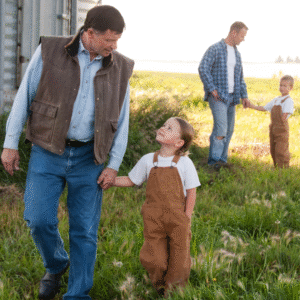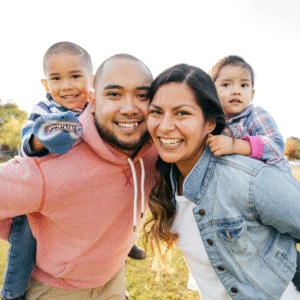In many rural communities, families take pride in teaching values of resilience and self-reliance to youth. Long-held beliefs travel from one generation to the next and shape the way young people approach life’s challenges. But in some cases, stigma may also get passed down.
Mental health stigma may be perpetuated in the quiet moments: the things we don’t talk about, the feelings we’re told to suppress, or the fear of what others might say. For some rural youth, opening up about mental health has never felt like an option. But it can (and should) be part of our conversations at home and in the classroom.
At the Stigma-Free Mental Health Society (SFMHS), we believe breaking the cycle of mental health stigma can start with you – rural educators, parents/guardians, and community leaders who want the best for your students and children. Here are some tips and resources to help you reduce stigma within rural families.
How Stigma Is Passed Down in Rural Families
Stigma can manifest in both overt and subtle ways. Maybe it’s a grandparent who never shared about their challenges with depression, or a parent who discouraged their child from expressing their emotions because they saw it as a sign of “weakness.” When mental health is treated as something to hide or be ashamed of, youth are more likely to carry those beliefs into adulthood. This can make it harder to ask for help later on, reinforcing the message that it’s better to keep things to yourself. But with compassion and support, we can rewrite the narrative.
To address the problem, it’s important to be aware of common beliefs that stigmatize mental health in many rural areas, such as:
- The belief that mental illness is not real; rather, people may exaggerate or “fake” it to get attention or avoid responsibilities
- Viewing mental illness as a choice that can be overcome by willpower alone, not a legitimate medical condition that may require treatment
- The idea that mental illness is shameful and should be kept as private as possible
- Assuming that dealing with mental health challenges makes someone less reliable and/or capable
Because of these views, youth may feel hesitant to open up about their struggles or seek support. So, what can we do to break the cycle?
 Creating Space for Healthy Conversations
Creating Space for Healthy Conversations
Caregivers and educators are often the first trusted adults in a young person’s life. You can be the one who helps a child feel safe enough to speak up. Here are a few small but powerful steps:
- Talk openly about mental health, just as you would physical health. Whether it’s naming your emotions honestly (“I’m feeling sad right now”) or talking about stress and self-care, it helps normalize the conversation.
- Challenge old beliefs: It can be helpful to identify and question the messages you received about mental health growing up. Saying things like “In our family, we talk about how we feel” or “It’s okay to ask for help” can interrupt the cycle and instill new values that reduce stigma.
- Model empathy: Listen without judgment when a young person shares how they’re feeling. Let children see you respond with compassion to both yourself and others.
- Use reliable resources: Sometimes, we don’t discuss mental health because we don’t know where to start. That’s where education makes all the difference.
Resources for Rural Educators and Caregivers 
SFMHS offers a variety of free, accessible programs designed especially for rural caregivers and school staff:
- The Rural Mental Wellness Toolkit is a resource hub created for rural individuals and families. It includes practical information, activities, and videos about mental wellness and stigma. We invite you to begin with our resources for Family Wellness and Supporting Youth.
- We also offer no-cost Stigma-Free Presentations for schools across Canada, including rural areas, either virtually or in person. Our presenters share their personal journeys related to stigma and mental health, along with an educational component that provides students with tools for mental well-being.
- On our Student Mental Health Toolkit, you’ll find Inspiring Stories for Youth – classroom-appropriate videos that can help students understand mental health and stigma. You’ll also find cross-curricular Lesson Plans and Downloadable Resources created for school staff, as well as Resources for Parents, Guardians, and Caregivers.
To learn more, check out our Rural Mental Wellness Program and Stigma-Free School Program.
The Cycle Can Stop with Us
 When we start having honest conversations about mental health, even if it feels uncomfortable, we begin to shift the story. You are already making a difference by being here and using these mental health resources – that’s something to be proud of. Keep up the great work and know that our team is supporting you along the way. If you have any questions about our programs or how to implement them in your area, please don’t hesitate to contact us.
When we start having honest conversations about mental health, even if it feels uncomfortable, we begin to shift the story. You are already making a difference by being here and using these mental health resources – that’s something to be proud of. Keep up the great work and know that our team is supporting you along the way. If you have any questions about our programs or how to implement them in your area, please don’t hesitate to contact us.
References
Crumb, L., Mingo, T. M., & Crowe, A. (2019). “Get over it and move on”: The impact of mental illness stigma in rural, low-income United States populations. Mental Health & Prevention, 13, 143–148.
Mental Health Commission of Canada. (2022, March 29). Rural and remote communities and suicide Fact Sheet.
Author: Monique Zizzo







